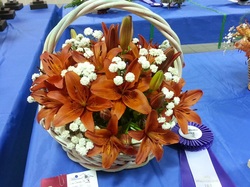 Picture taken at Lily Show 2013
Picture taken at Lily Show 2013 The following information is compliments of The Canadian Flower Arranger, The Garden Clubs of Ontario 1993, Canadian Cataloguing Publication Data, Creative Floral Designs , Carolyn R. Hawkins and Jeannine F. Fox and The Garden
Club of Georgia, Inc. Athens.
A design is an arrangement of fresh and/or dried plant material and/or inorganic objects arranged to produce an artistic unit.
It evolves as the arranger integrates his or her own imagination and creativity with the principles and elements of design.
Line forms the structural framework of all these designs and it is the visual path along which the eye is led from one the point of interest to another. As the primary foundation of all designs, it can convey interpretation, it suggest a mood or an idea, etc.
Line directions may be vertical, horizontal, diagonal and /or curved. Line may be composed of linear materials or created through the repetition of form, size, texture and colour in linear
directions.
Tip:
In the traditional line design avoid the temptation to over fill the arrangement.
Take care that there is space between each element of plant material to show each to advantage.
In geometric designs every stem radiates or appears to radiate from a central area.
There should no strong surprises or contrast. Variation is soft and gradual.
In geometric designs you want line foliage to create the outline; plain smooth leaves to reinforce the
structure and round leaves for focus. A few sprays of flowers to support the round shape of the lilies.
Tip:
In the line design keep the materials simple and very clean.
Take care with visual balance to create stability.
Use containers that are dark as the plant materials. Keep the dark colours low in the container.
Keep the center of interest approximately two-thirds of the way down from the tallest placement. Angling some plant material to hide the rim of the container and allow the plant material and the container to belong to each other and appear stable.
Do remember that the design an be seen from all sides.
You want the scale of the design to be appropriate to the space given for its placement.
Scale is the size relationship to all components.
** Remember these are not rules just guidelines to get you going! **

 RSS Feed
RSS Feed